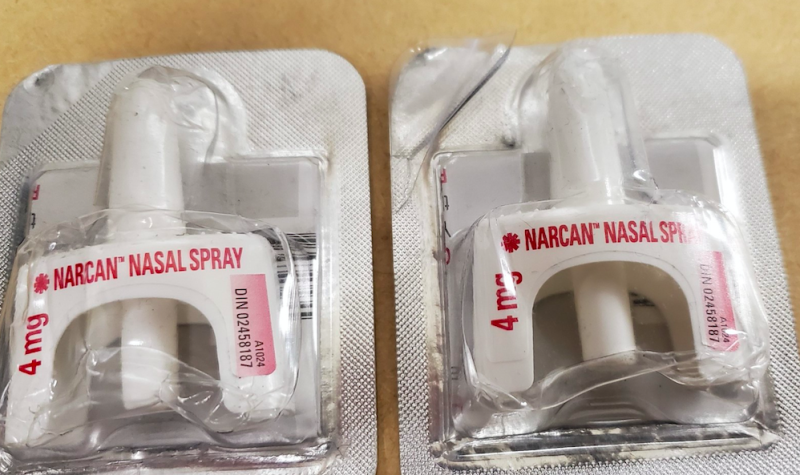FORT FRANCES — The impact of the opioid epidemic across Northern Ontario has taken its toll on many individuals, family members, and communities.
Recently, Ontario Provincial Police in the Rainy River district reported in 30 days they've encountered three people that died as a result of opioid overdose.
Kali Solmundson, a public health nurse with Northwestern Health Unit in Fort Frances, said they have experienced “a lot more opioid toxicity in our area.”
“We're seeing the emergence of a substance called xylazine and that's being mixed into the drug source as it kind of has similar effects to opioids on the body,” said Solmundson.
Xylazine is a veterinary sedative used for sedation, anaesthesia, muscle relaxation, and analgesia in large mammals such as horses.
This veterinary sedative is being mixed in the drug supply and being sold to users without their knowledge.
“It is within the drug supply now just because it can produce some of the same kind of feelings that people might seek with opioid use,” Solmundson said.
Opioids affect the part of the brain that regulates breathing.
“Opioids normally bond to receptors in our brain in order to create that euphoric feeling, but it also creates respiratory depression and other negative side effects that can be lethal,” said Solmundson.
The OPP's role is to investigate opioid-related incidents and apprehend those who produce, import, and traffic illegal drugs, but not all opioids are illegal.
Prescription users of opioids can overdose if they are misusing opioids more often or at higher doses than recommended and taking them with alcohol or sedatives, such as sleeping pills, muscle relaxants, and benzodiazepines.
When someone is showing signs of an overdose, the brain may no longer be able to control basic life functions, like breathing. Signs of an overdose include blue lips, fingernails or toenails, slow or no breathing, faint pulse or no pulse, pale and clammy skin, unresponsive to calling their name or to pain, and snoring or gurgling noises while appearing asleep.
OPP Const. Michael Glueheisen advises that individuals seeking emergency help during an overdose have some protection under the Good Samaritan Drug Overdose Act.
“The intention of the Act is to reduce fear of police attending overdose events and embolden people to seek life-saving assistance and stay with the victim in the event of an overdose. This is particularly important in the face of the opioid crisis. The GSDOA applies to anyone seeking emergency support during an overdose, including the person experiencing an overdose. The Act protects the person who seeks help, whether they stay or leave from the overdose scene before help arrives. The Act also protects anyone else who is at the scene when help arrives,” Glueheisen said.
Solmundson and the health unit go out into the community to do presentations on harm reduction strategies like education on the proper use of naloxone, which is a free life-saving medication that can be used in the event of an overdose to temporarily reverse the effects of the opioid.
“Naloxone has a stronger affinity or kind of like a pull towards these receptors. So, if you can picture a kind of magnet, it's like a stronger magnet. It will knock the opioids off of the brain receptors, making sure that they have no action on the brain, and then blocking those receptors so that those effects are reduced or mitigated,” Solmundson said.
Naloxone comes in two forms; an injection or nasal spray. The nasal spray is more common at the Northwestern Health Unit.
The spray works as a one-time dose and it takes about one to five minutes to be effective, according to Solmundson. CPR is also recommended while Naloxone is taking effect.
If the individual is still not responsive in two or three minutes, a second dose may be necessary.
However, it is advised that the person seek medical attention after using Naloxone.
“Naloxone only lasts for about 45 to 90 minutes in the body. So, there's always a risk of reoccurring overdose as Naloxone works its way out of the body because many opioids have a longer life in our body than Naloxone. They can re-bind to those receptors and then someone can re-overdose,” said Solmundson.
People can get Naloxone at their local health unit office, pharmacies, and Ontario Addictions Treatment Centre.
“If anyone came in and we just go over training quickly with them, make sure they're aware of how to use it when they would use it, how to go safely about things,” Solmundson said.
As well, people can go to the health unit office to get testing strips that will detect xylazine in their drug supply.
“It’s a newer thing that's happened within the last couple of months. We're trying to educate and push out,” said Solmundson
The testing strip work similarly to a COVID test where users would mix some of the drug in a saline solution. If the strip shows two lines, the drug is negative and one line it’s positive for xylazine.
"You let it sit for a little while and then you can see if it's positive or not and then kind of make your informed decision from there,” Solmundson said.
Although this strip tests for xylazine, the health unit also has a test strip that detects fentanyl.
For more information on opioids and how to get a naloxone kit, visit unfc.org or nwhu.on.ca.
